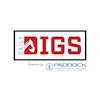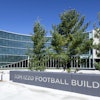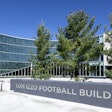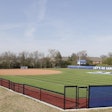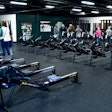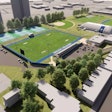![[Photos courtesy of Danley Sound Labs]](https://img.athleticbusiness.com/files/base/abmedia/all/image/2020/01/ab.sound120_feat.png?auto=format%2Ccompress&q=70&w=400)
Between screaming fans, coaches communicating to their athletes, and sound systems themselves — the noise within a sports facility can crescendo into an unpleasant cacophony.
"It is actually fatiguing to be in a noisy environment like that," says Skip Welch, national accounts manager for Danley Sound Labs. "Your spectators are experiencing something that is not exactly the most pleasurable experience — coming to a game."
Similarly, a fitness area with poor audio design can create a difficult environment for members — one that people will notice. "Gym owners could just go on Yelp, just pull up your gym and see what the reviews are like," says Joshua Haydon, director of business development for AV Now Fitness Sound. "I notice a lot of complaints saying, 'The sound system doesn't work.' "
Any facility will benefit from crafting a comfortable auditory environment. If you're hoping your facility strikes the right tone with patrons, consider the following:
![[Photo courtesy of Danley Sound Labs]](https://img.athleticbusiness.com/files/base/abmedia/all/image/2020/01/ab.sound1_120.png?auto=format%2Ccompress&fit=max&q=70&w=400) [Photo courtesy of Danley Sound Labs]
[Photo courtesy of Danley Sound Labs]
Designing big spaces
Acoustics can often take a back seat when it comes to design, but those looking to provide a quality environment would do well to consider it upfront, when the cost of making changes is lower. "It's easiest to do when it's being constructed," says Welch, whose work includes athletic venues both large and small. "It's a lot more difficult to do it afterward."
Acoustic consultants can be brought in to work with an architecture firm and make recommendations to create an ideal sound environment from the start. A consultant should be able to review the materials of a room and make suggestions on various acoustic treatments, which may include everything from spray-on material that can be applied to ceilings and walls to sound panels that can be hung in a facility's rafters to help dampen or absorb sound.
Facilities lacking in such acoustic treatments can present problems. Welch recently worked with a hockey facility that removed the acoustic treatment from its ceiling during a renovation, leaving behind a metal surface.
"Now you've got two parallel surfaces that are hard and reflective — the ice surface and the ceiling," he says. "So just the players on the ice, no sound system, just the environment itself, becomes extremely noisy."
"Sound has to decay," Welch says, noting that in an environment without acoustic treatment, where sound is free to bounce and reflect, that decay can take much longer, resulting in what Welch calls a high "noise floor." Adding fans and a sound system only makes it noisier and more unpleasant.
Considering sound when designing a space can make installing a sound system easier once the space is built out.
"When they build the building, architects draw up all the plans according to where we need things," says Haydon, whose firm consults with architects on fitness facility builds. "The general contractors make sure there's conduit in the wall, that there's backing where the speakers need to go, that type of deal. It cuts down on costs."
However, even in a pre-existing room without acoustical finishes, many speaker and audio equipment manufacturers can still design an environment that will result in a pleasant experience with the help of high-tech software tools and modeling techniques.
Software can be deployed to create an accurate model of an acoustical environment, considering things like materials, acoustical treatments and absorption coefficients that inform a facility's sound design.
"They can tell you how much sound will be absorbed, how much will reflect, and it can actually predict speech intelligibility index numbers," says Welch. "It's pretty amazing stuff."
AV Now Fitness Sound's technique has removed some of the guesswork of tuning a particular sound system to a particular room. "We've gone out to multiple areas with sound engineers and loaded all the speakers and microphones in there and have actually walked around the room with a microphone," Haydon says. "We played different songs at different BPMs [beats per minute] and levels, and then created this file or preset that matches the amplifier and the speakers that will fit in any size room.
"We can take the floor plans and know exactly how the room is designed. Once we have that we can plot different areas in the room and then change up what speakers we recommend for those areas."
![[Photos courtesy of Danley Sound Labs]](https://img.athleticbusiness.com/files/base/abmedia/all/image/2020/01/ab.sound2_120.png?auto=format%2Ccompress&fit=max&q=70&w=400) [Photos courtesy of Danley Sound Labs]
[Photos courtesy of Danley Sound Labs]
Environmental variables
Sound design considerations can vary widely depending on the facility context. An indoor arena, for instance, will not have the same concerns as an outdoor stadium.
"It's a whole other thing," Welch says of designing an outdoor sound environment. "Now you don't have to deal with the acoustic environment of surfaces, but you have to deal with the weather environment. You have air absorption."
Meanwhile, in the fitness environment, a room's sound design might vary depending on its primary use. "On a bike, it's a little different because you want more of a punchy bass feel," says Haydon. "We typically do more subwoofers in the cycle room."
Aquatics environments demand additional considerations. Haydon says that while there are sound systems designed to withstand harsh pool environments, and some of his customers still request them for their aquatic aerobics areas, AV Now Fitness Sound has begun recommending portable systems for those facilities.
"That's a little bit different, of course, because the users are in the pool," Haydon says. "So their head is at ground level. You just roll the speaker and put it out next to the pool where the users can hear it."
Regardless of the environment, however, some concerns will remain constant. Sound design should be considerate of neighbors, while still prioritizing the ability to convey safety information in an intelligible way.
"If the environment is difficult for speech intelligibility, that means that the life-safety enunciators are going to have difficulty getting the word to people that they need to evacuate," says Welch. "There are things that are being done to create a speech intelligibility threshold. In some cases, you cannot occupy the room if the life-safety system doesn't meet a certain threshold."
One final consideration is the distortion factor. According to Welch, distortion — where an audio signal is altered — can occur when sound systems are pushed beyond their limits. "If you've been to a rock concert and you've come away with your ears ringing, well, that's because the sound system was operating with a high distortion factor," he says.
Systems with a high distortion factor can create an unpleasant environment. "It can be perceived as being louder," Welch says, "But it's also more fatiguing. A more accurate loudspeaker with less distortion is less fatiguing. Now you can also have it louder, but it's not as painful."
When used in a sports context, the term "hostile environment" typically refers to a difficult place for visiting teams to play. But the very thing that makes an environment hostile — sound — shouldn't negatively affect your patrons. Taking acoustics into account when designing any given facility environment is critical to creating a pleasant experience for fans, athletes, coaches and fitness enthusiasts alike. Says Welch, "The acoustic environment of any facility plays a major role in the overall experience."
Music mattersFor patrons of fitness facilities, the right soundtrack really can provide a boost in the midst of a challenging workout. A study published in Psychology of Sport & Exercise subjected a group of exercisers to sprint-interval training coupled with music intended to be motivational. The group later repeated the exercise, once while listening to a podcast, and again while listening to no audio at all. A New York Times article on the study reported that the research team, seeking to discern whether the music had had a positive effect, asked subjects to rate the exercise experience afterward in terms of how hard they had exerted themselves and how much they enjoyed it. Researchers also measured more objective data, such as heart rates and power output. The study found that not only had the subjects reported enjoying the difficult exercise more when listening to music, the data they generated during music-backed workouts indicated they had exerted themselves most with a musical soundtrack — all this despite reports rating the sessions' difficulty remaining constant regardless of what exercisers were listening to. AV Now Fitness Sound's Joshua Haydon says that the study reveals the importance of a quality sound system, particularly to facilities that utilize group exercise. "The sound of the class, energizing everyone and not cutting in and out — it's important," he says. "It keeps the members coming back." |
This article originally appeared in the January | February 2020 issue of Athletic Business with the title "Sounds about right: Creating a pleasant acoustic experience." Athletic Business is a free magazine for professionals in the athletic, fitness and recreation industry. Click here to subscribe.












